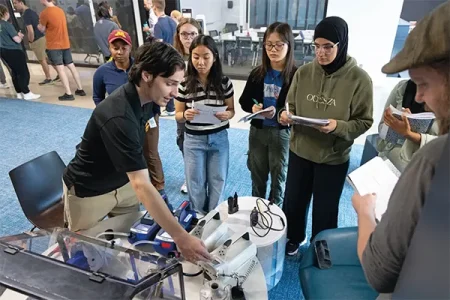From sugary drinks to vaccines, and seatbelts to family planning — public health and politics have long intertwined. But in recent years, that entanglement has become a gridlock.
To School of Public Health (SPH) Associate Professor Sarah Gollust, public health is “a political undertaking.” While personal health-related decision making is private, public health works with the government to develop and enforce laws that make population-based health decisions for us.
One reason the standoff between identity politics and public health policy has felt more contentious lately is COVID-19. “Polarization is more consequential when the thing being polarized is an infectious disease,” says Gollust, who specializes in the relationship between public health policy, political identity, and communication.
“Journalists can do a better job of presenting the whole picture and not just devoting attention to one study without the context of past and future research.”
Sarah Gollust
Climate change has also churned the political waters around public health policy. Increasing global temperatures caused by climate change threaten human health in various ways. “That increase in degrees often elicits a shrug and a comment about, ‘Not minding winters being a bit warmer…’,” says Assistant Professor Jesse Berman, a climate change expert. “However, this is a misconception. We anticipate a wide range of health effects resulting from climate change and no person or population will be untouched.” Still, since the 1970s, polarization around climate change policy has long stalled public health officials’ ability to introduce and enact policies that better protect the public’s health.
Striving for objectivity
Whether it’s COVID-19 or climate change, media coverage and consumption habits exacerbate polarization. Gollust’s research shows that journalists often cover the controversy behind health policy rather than the policy itself. News is often focused on which political party is “winning” and which is “losing” — an approach Gollust calls the “conflict frame.”
Commercial incentives to get “eyeballs on the news” and journalism’s emphasis on balanced reporting keep the conflict frame perpetually hampering movement on vital issues. But readers can’t necessarily decipher the balance of truth and evidence when journalists focus on providing both sides instead of what the evidence says. “It’s much better to be really clear about where the preponderance of evidence lies,” says Gollust.
According to Gollust’s research, when journalists do cover scientific evidence, they often focus on emerging studies without analyzing the larger conversation. “Journalists can do a better job of presenting the whole picture and not just devoting attention to one study without the context of past and future research,” she says.
On the other side of the screen, audiences have a responsibility, too. Most consume media with pre-existing biases and opinions that create what Gollust calls a “motivated reasoning response” among audiences. A motivated reasoning response is when we interpret policy through our political orientation rather than prioritizing accuracy. Being aware of this process can help us all better interpret health policy information to shape well-rounded opinions grounded in facts rather than identity politics.
Scientists and legislators can also nurture relationships between one another to help ensure that scientific evidence, not polarization, drives policymaking, says Gollust. Stronger connections can help give research a bigger role in policy-making. They help make research that might be behind a paywall or buried in the large pile of information more directly accessible to legislators. Relationships can also better align the studies scientists conduct with the questions policymakers face. Lastly, relationships can increase scientific literacy among electived officials, so they can better interpret research.
Will science ever completely outweigh polarizing politics and people’s own Ioyalties, fixed ideas, and fears? It never has and it probably never will, but that doesn’t mean we can’t make strides in that direction with the aim of creating better health outcomes for individuals and communities.



